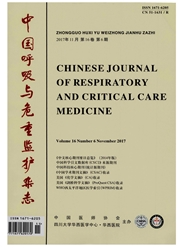

 中文摘要:
中文摘要:
目的构建稳定表达谷胱甘肽S转移酶mu5(GSTM5)的人支气管上皮16HBE细胞株,探讨诱导GSTM5核转位的关键因素。方法构建表达GSTM5基因的重组慢病毒载体(PLVX-puro-GSTM5-SBP-3*flag-N、PLVX-puro-3*flag-SBP-GSTM5-C)并制备出相应的慢病毒,感染人支气管上皮16HBE细胞后,经嘌呤霉素筛选获得细胞克隆;实时荧光定量PCR和蛋白印迹法(Westernblot)分别检测细胞株中GSTM5的mRNA、蛋白表达水平;以肿瘤坏死因子-α(TNF-α;10ng/ml)刺激稳定转染细胞株(稳转株)0.5h,共聚焦荧光显微镜检测GSTM5核转位。结果成功构建稳定表达GSTM5人支气管上皮细胞株(16HBE-GSTM5-SBP-3*flag-N、16HBE-3*flag-SBP-GSTM5-C);荧光共聚焦显微镜显示稳转株在TNF-α刺激诱导后,GSTM5由胞浆转入胞核,以16HBE-GSTM5-SBP-3*flag-N稳转株更显著。结论TNF-α刺激可诱导GSTM5人支气管上皮细胞株中GSTM5发生核转位,可能与其N端含有非经典核定位信号密切相关。
 英文摘要:
英文摘要:
ObjectiveTo establish 16HBE cell lines stably expressing glutathione S-transferase mu 5 (GSTM5) gene, and explore the mechanism of GSTM5 nuclear translocation. MethodsRecombinant lentiviral expression vector containing GSTM5 gene was constructed and lentivirus was produced. After lentivirus infection of 16HBE cells, 16HBE-GSTM5 cell lines were obtained by screening with puromycin. Expression of GSTM5 in different cells was examined by RT-qPCR and Western blot. The nuclear translocation of GSTM5 was observed by confocal laser scanning microscope, after the 16HBE-GSTM5 cell lines were treated with tumor necrosis factor-α (TNF-α; 10 ng/ml) for 0.5 hour. ResultsLentiviral expression plasmids, PLVX-puro-3*flag-SBP-GSTM5-C and PLVX-puro-GSTM5-SBP-3*flag-N, were constructed and lentiviral particles were successfully packed. After infected with lentivirus and screened by puromycin, two cell lines, 16HBE-GSTM5-SBP-3*flag-N and 16HBE-3*flag-SBP-GSTM5-C, were obtained. GSTM5 expression in these two cell lines was significantly higher compared with the control group and parental cells. After treated with TNF-α for 0.5 hour, the nuclear translocation of GSTM5 in 16HBE-GSTM5-SBP-3*flag-N was much more obviously than that in 16HBE-3*flag-SBP-GSTM5-C. ConclusionThe N-terminal region of GSTM5 is critical for nuclear translocation induced by TNF-α, which is mediated by a novel and non-classical nuclear localization signal.
 同期刊论文项目
同期刊论文项目
 同项目期刊论文
同项目期刊论文
 期刊信息
期刊信息
